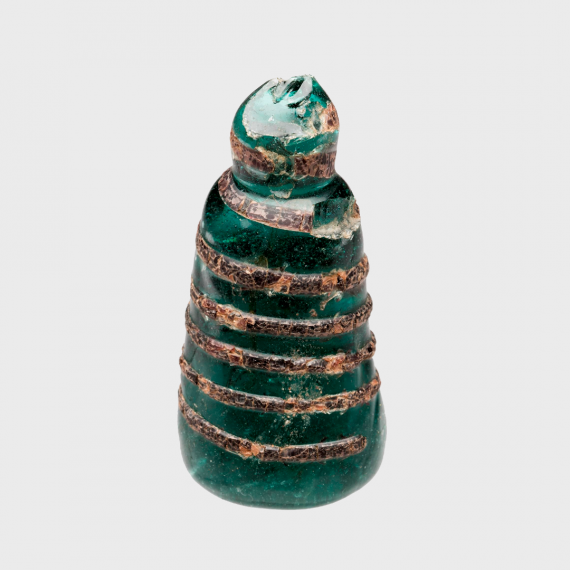Historic contacts between Sweden and Ukraine
February 24, 2022 will always be a dark day in the history of Europe. The Swedish History Museum and the National Historical Museums commemorate this with a research project and a mini-exhibition showing historical contacts between Sweden and Ukraine, on view until further notice.

Historic contacts between the nations
There is ample evidence of contacts between Scandinavia and Ukraine during the Viking Age. Trade, plunder and warfare were motives behind journeys to the east, and many Scandinavians settled there. Objects with direct counterparts in the Viking city of Birka have been found in the burial ground in Shestovytsia. DNA analyses reveal there were Scandinavians among the buried.
The close contacts continued after the Viking Age. In 1019 the daughter of King Olof Skötkonung, Ingegerd, married Prince Jaroslav of the Rurikids. According to legend, the Rurikids were descendants from Rurik who traveled across the Baltic Sea to Kyiv/Kyiv. Their symbol, a diving bird of prey, can today be found in the coat of arms of Ukraine.
In the collections of the Swedish History Museum and the Economy Museum – Royal Coin Cabinet, there are objects that show historical contacts with today’s Ukraine. A selection of these items, Viking silver coins, glass game pieces and a silver cap ornament will be on display at the Swedish History Museum until further notice. You can see a selection of these objects below.
New research in progess
As a result of Russia’s invasion of Ukraine, the National Historical Museums are initiating a research project aimed at comparing the collections at historical museums in Sweden and Ukraine.
Archaeological and historical objects that originate in Ukraine can be found in Swedish museums. The same applies to Nordic objects in Ukrainian museums. The artefacts are evidence of the contacts between the countries during different historical periods. The aim of the research project is to highlight this material and examine how the collections can influence national identities and perceptions. Bringing these contexts to light is particularly important at a time when the Ukrainian cultural heritage is under threat, both from Russian state ideology and the military invasion.
The research project runs during 2023 – 2025 and is financed by the Torsten Söderberg Foundation.
In Ukranian
Існує багато свідчень контактів між Скандинавією та Україною в добу вікінгів. Торгівля, грабунки та військові походи були основними чинниками подорожей на схід і багато скандинавів залишалися там жити. У могильнику поблизу с. Шестовиці на Чернігівщині знайдено багато виробів, які подібні до тих, які відомі у місті вікінгів Бірці. Вивчення давнього ДНК похованих підтверджує те, що серед похованих у Шестовиці були скандинави. Контакти продовжувалися і у більш пізній час. 1019 року була видана заміж дочка Олава Шотконунга Інгегерд за князя Ярослава з роду Рюриковичів. Згідно легенди, Рюриковичі, які потім осіли у Києві, прийшли “з-за моря”. Символом їх роду був пірнаючий хижий птах, мотив якого можна побачити у обрисах державного гербу України.
Актуальне дослідження: Історичні звʼязки між Швецією та Україною
На тлі вторгнення Росії в Україну Державний Історичний Музеї Швеції розпочинає дослідницький проект з фокусом на музейних збірках історичних музеїв Швеції та України. У музеях Швеції зберігаються археологічні та історичні предмети та документи, що походять з України. З іншого боку, предмети скандинавського походження відомі також в українських музеях. Цей матеріал є доказом контактів між країнами в добу вікінгів, раннє середньовіччя та ранньомодерний час. Мета дослідницького проекту полягає в тому, щоб звернути увагу на цей матеріал та дослідити, як колекції використовувалися історично та як вони можуть впливати на національну ідентичність та її сприйняття. З’ясування цих контекстів є особливо важливим у час коли українська культурна спадщина знаходиться під загрозою як російської державної ідеології так і військового вторгнення.
Проект «Швеція та Україна в історії музейних колекцій та виставкових наративах» триває протягом 2023 – 2025 років і фінансується Фондом Торстена Сьодерберга.
A selection of objects

Hat decoration of silver, from grave Bj 644 in Birka, Sweden. 10th century. The object was placed on the top of a silk hat and is one of only three known of its kind: two from Birka and one from Shestovytsia. In the collections of the Swedish History Museum. The photographs show a reconstruction of the hat from grave Bj 581 in Birka. Photo: Tallee Savage.
Срібна прикраса шапки з поховання 644 могильника Бірки. X ст.
Річ прикрашала верхівку шовкової шапки і є однією з трьох відомих: двох з Бірки і одниєї з Шестовиці. Фотографії реконструкції шапки з поховання 644 могильника Бірки. Фото: Tallee Savage

Game pieces of glass, from chamber grave Bj 644 in Birka, Sweden. 10th century. There is a similar set from Shestovytsia, also found in a chamber grave. The photographs show the game piece known as the king from Shestovytsia and Birka respectively. In the collections of the Swedish History Museum. Photo: Rógvi N. Johannesen, Ola Myrin.
Скляні “шахи” з камерного поховання 644, Швеція. X ст.
У Шестовиці є дуже подібний набір, який також знайдено у камерному похованні. На фотографіях зображено фігури “короля” з Шестовиці та відповідно з Бірки.
Фото: Rógvi N. Johannesen, Ola Myrin.

Silver coin, part of a treasure find from Sigsarve. Gotland, Sweden. Minted in the Kievan Rus for Prince Vladimir (980–1015). Next to Vladimir’s left shoulder is a stylized bird of prey, the emblem of the Rurikids. In the collections of the Economy Museum – Royal Coin Cabinet. Photo: Gabriel Hildebrand/SHM (CC BY)
Срібна монета, фрагмент із скарбу у Сігсарве на Готланді.
Карбована у Києві князем Володимиром (980-1015). Біля лівого плеча Володимира видно схематичне зображення хижого птаха – символа Рюриковичів. Фото: Gabriel Hildebrand

Silver coin, probably found in the area of Strängnäs, Sweden. Minted in the Kievan Rus for Prince Yaroslav (1019–54). The reverse shows the emblem of the Rurikids. The coin has been reused as jewellery. In the collections of the Economy Museum – Royal Coin Cabinet. Photo: Gabriel Hildebrand.
Срібна монета, ймовірно знайдена у районі Стренгнесу.
Карбована на Русі князем Ярославом (1019-1054). На одній из сторін монети зображено емблему Рюриковичів. Монета згодом використовувалася як прикраса. Фото: Gabriel Hildebrand/SHM (CC BY)